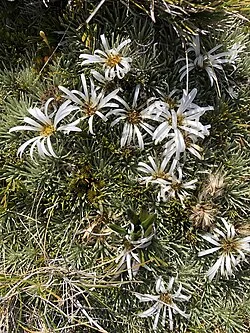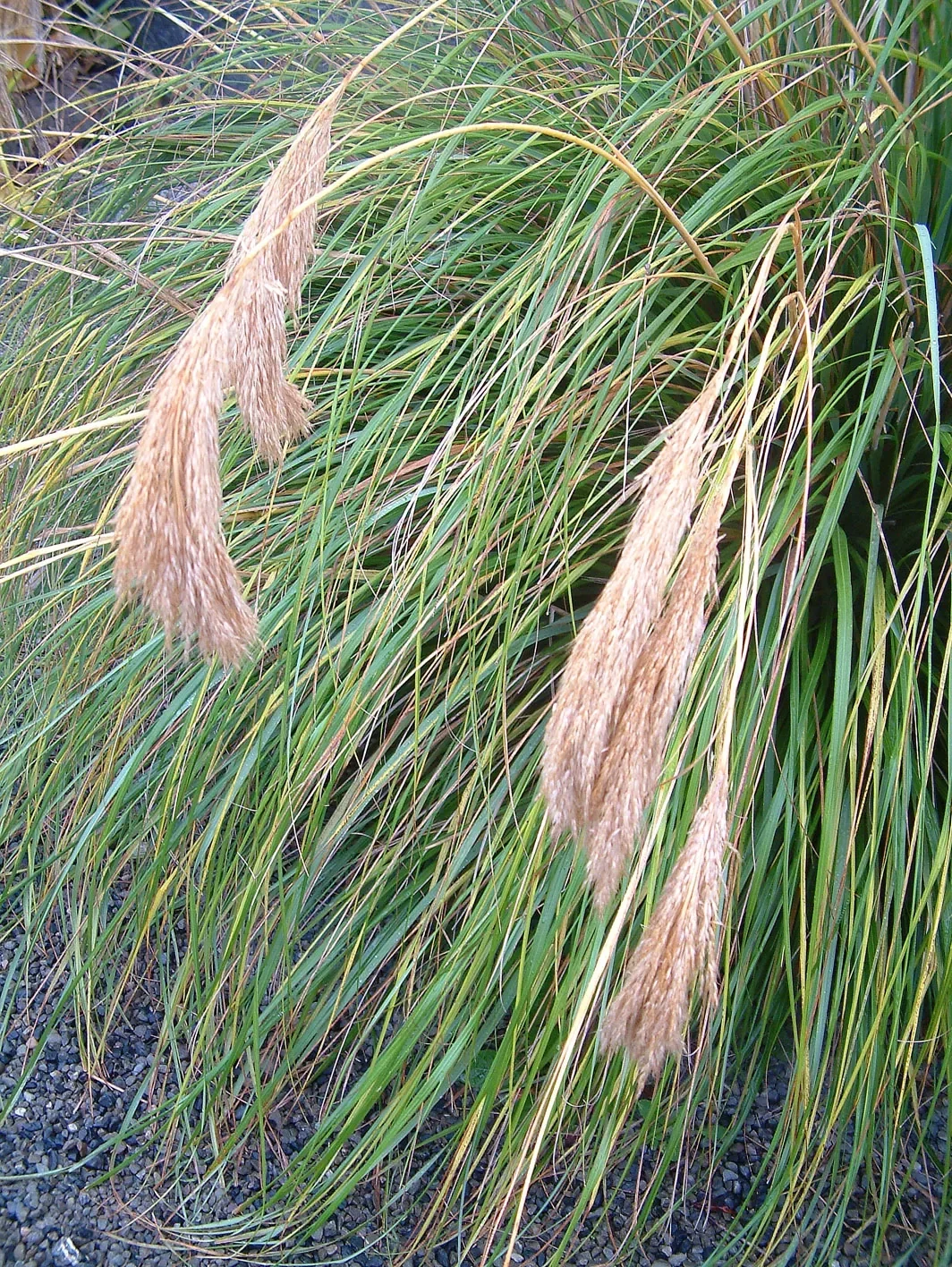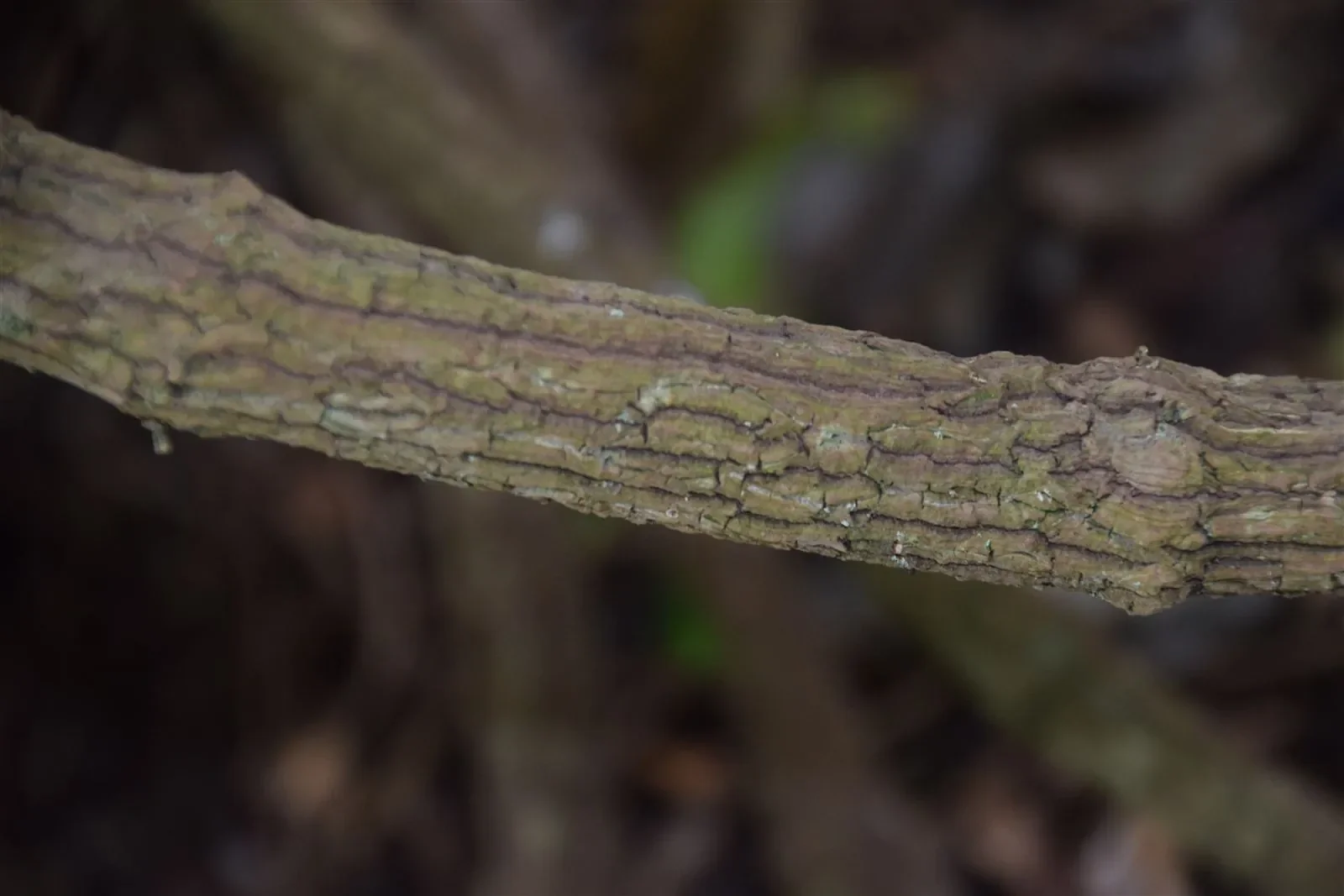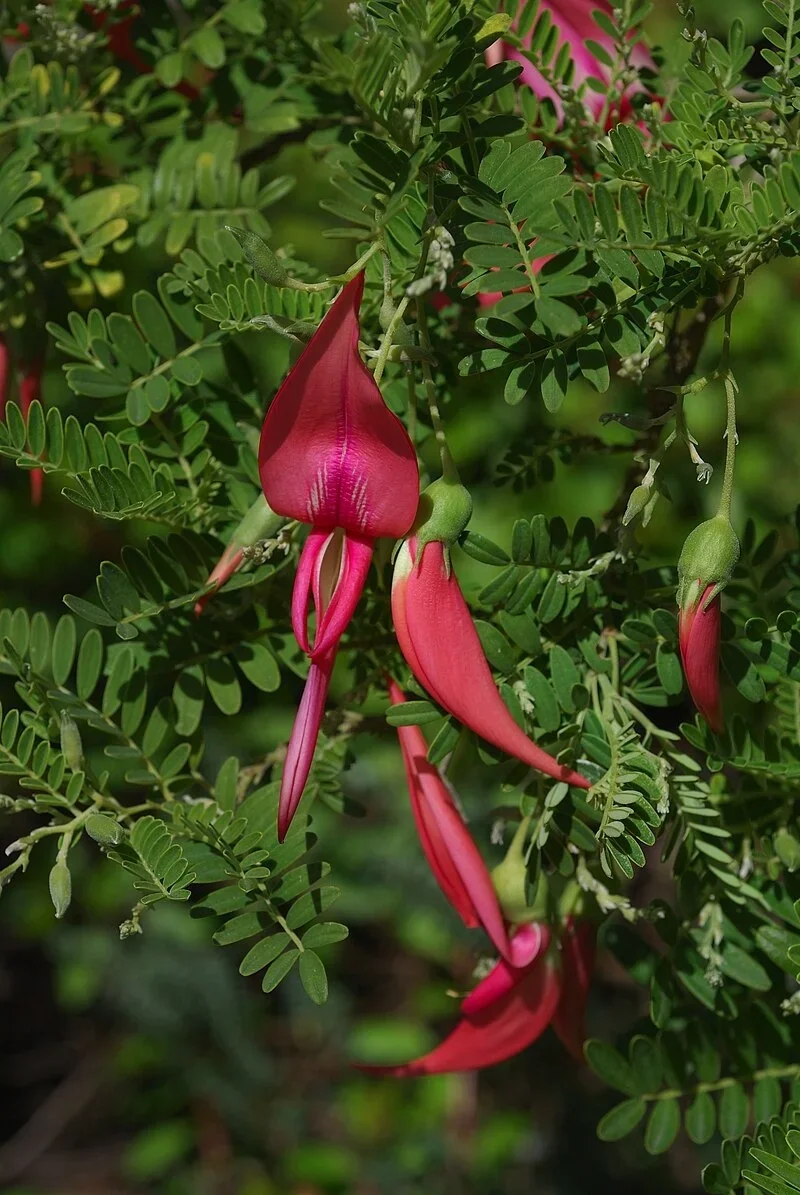
Lyall's Mountain Daisy
Celmisia lyallii
Lyall's Mountain Daisy (Celmisia lyallii) stands as one of New Zealand's most spectacular alpine flowering plants, renowned for its magnificent large white daisy blooms that illuminate the high country landscape during summer. Endemic to the South Island's mountain regions, this robust perennial has evolved to thrive in some of New Zealand's most challenging environments, from alpine grasslands to rocky outcrops above the treeline. With flowers that can reach up to 8cm across and distinctive silver-backed leaves, this species represents the pinnacle of alpine daisy evolution in New Zealand. The plant's ability to create stunning displays in harsh mountain conditions makes it highly prized in alpine plant cultivation and rock garden design.

Plant Description
Celmisia lyallii, commonly known as Lyall's Mountain Daisy or False Spaniard, is a rigid, tufted perennial herb endemic to the South Island of New Zealand. It forms a basal rosette of dense, silver-green leaves that are long, narrow, and spear-shaped, tapering to a sharp, pointed apex. The leaves are typically 20-60 mm long, with a smooth upper surface and a densely white, satiny underside, which helps conserve moisture and protect against cold. In summer, it produces spectacular large white daisy-like flowers with golden centers, held above the foliage on stout stalks. This alpine specialist thrives in montane to subalpine open grasslands and rocky areas, and is known for its resilience in harsh environments.
Quick Facts
| Scientific Name | Celmisia lyallii |
|---|---|
| Height | 0.3-0.6 m |
| Spread | 0.5-1 m |
| Water Needs | Low to moderate, excellent drainage essential |
| Light | Full sun |
| Frost Tolerance | Excellent, adapted to alpine conditions |
| Salt Tolerance | Low |
| Growth Rate | Slow |
| Lifespan | Long |
Climate Best Suited to
Lyall's Mountain Daisy (Celmisia lyallii) naturally occurs in the alpine and subalpine zones of the South Island, where it experiences cool summers, cold winters, and significant temperature fluctuations typical of high mountain environments. This species thrives in areas with excellent air drainage, low humidity, and intense UV radiation that characterize alpine conditions. The plant is adapted to the short growing seasons and long, snow-covered winters of the high country, making it suitable for cool climate gardens that can replicate these conditions.
Regional Suitability
| City | Climate Suitability |
|---|---|
| Whangārei | Poor |
| Auckland | Poor |
| Hamilton | Moderate |
| Tauranga | Poor |
| Rotorua | Good |
| Gisborne | Poor |
| New Plymouth | Moderate |
| Napier | Moderate |
| Whanganui | Moderate |
| Palmerston North | Good |
| Wellington | Good |
| Nelson | Good |
| Christchurch | Ideal |
| Dunedin | Ideal |
| Invercargill | Ideal |
Habitat
Celmisia lyallii, commonly known as Lyall's Mountain Daisy or False Spaniard, is endemic to New Zealand's South Island. Its natural habitat includes montane to subalpine open grasslands, herb-fields, and fell-fields, primarily found east of the main divide in drier areas.
This species is widespread in these high-country regions and is known for its resilience, often being one of the first plants to colonize areas that have been disturbed by grazing or burning. Celmisia lyallii thrives in environments tolerant of frost, sun, wind, and free-draining conditions, making it well-adapted to the harsh alpine climate of New Zealand's high country.
Plant Conservation
Conservation Status
Celmisia lyallii is classified as "Not Threatened" under the New Zealand Threat Classification System, indicating stable populations within its natural alpine distribution range. However, as a specialist alpine species, it faces ongoing conservation challenges from climate change, habitat modification, and recreational pressure in high-country areas.
This endemic South Island species is restricted to mountainous regions above 900 meters elevation, primarily in Canterbury, Otago, and Westland. Its specialized habitat requirements for cool, moist conditions and well-drained alpine soils make it vulnerable to warming temperatures and changing precipitation patterns associated with climate change. Populations may face upward migration pressure as suitable habitat shifts to higher elevations.
Conservation efforts focus on protecting alpine habitat integrity and monitoring population responses to environmental changes. The species benefits from protection within national parks and conservation areas, though recreational activities like tramping and skiing can create localized disturbance. Ex-situ cultivation in specialized alpine gardens helps preserve genetic diversity and provides opportunities for research into cultivation techniques for potential habitat restoration efforts.
Climate change adaptation strategies include monitoring population trends, protecting habitat corridors that allow for altitudinal migration, and maintaining cultivation expertise for potential future conservation interventions. The species' striking appearance and conservation value make it an important flagship species for alpine ecosystem conservation in New Zealand.
Growing Requirements
Soil Requirements
Lyall's Mountain Daisy (Celmisia lyallii) requires exceptionally well-drained soils that replicate the rocky, gravelly conditions of its alpine habitat. The species cannot tolerate waterlogged conditions and prefers soils with high stone content that provide excellent drainage and prevent root rot. In cultivation, raised beds or rock gardens with added gravel and pumice are essential for successful growth.
- Requires exceptional drainage - cannot tolerate waterlogging
- Prefers rocky, gravelly soils with high stone content
- Benefits from added pumice or coarse gravel for drainage
- Suitable for raised beds and rock garden situations
- Tolerates poor, nutrient-deficient soils typical of alpine zones
Light Requirements
Lyall's Mountain Daisy (Celmisia lyallii) requires full sun exposure to thrive and produce its spectacular flowering displays. The species has evolved to handle intense UV radiation at high altitudes and needs maximum light exposure to maintain its compact growth habit and silvery foliage characteristics. Any shading will result in poor flowering and elongated, weak growth.
- Requires full sun exposure for optimal growth and flowering
- Adapted to intense UV radiation of alpine environments
- Shading results in poor flowering and weak growth
- Benefits from exposure to cool air movement
- At least 8 hours of direct sunlight daily essential
Water Requirements
Lyall's Mountain Daisy (Celmisia lyallii) has low to moderate water requirements, reflecting its adaptation to the dry conditions that can occur in alpine environments. The species requires careful watering that maintains slight soil moisture during the growing season while ensuring excellent drainage prevents waterlogging. Winter dormancy periods require minimal watering.
- Low to moderate water requirements during growing season
- Requires consistent drainage - never waterlogged
- Can tolerate periods of drought once established
- Minimal watering required during winter dormancy
- Water at soil level to avoid wetting silvery foliage
Planting Guide
When to Plant
The ideal time to plant Lyall's Mountain Daisy (Celmisia lyallii) is in spring, after the last risk of severe frost has passed, or in early autumn, allowing the plant to establish before winter dormancy. Planting seedlings in the middle of spring is often recommended.
Site Selection
Choose a site that mimics its natural alpine habitat:
- Light: Full sun exposure is crucial for optimal growth and flowering. While it thrives in sunny conditions, in warmer climates, a partially shaded site is often recommended to protect it from intense heat.
- Soil: Requires exceptionally well-drained, acidic soil, ideally rich in organic matter. It can tolerate various soils from pure peat to lean scree. Good drainage is paramount to prevent root rot.
- Climate: Adapted to cool, moist alpine and montane conditions. It is resilient to frost, sun, and wind, but dislikes humidity and will not tolerate drying out. It is not suited for warmer, more humid parts of New Zealand.
Planting Procedure
- Prepare the Soil: Ensure the planting site has exceptionally well-drained soil. Amend heavy soils with plenty of grit, coarse sand, or pumice to improve drainage, replicating its natural rocky, gravelly alpine habitat.
- Dig the Hole: Dig a hole that is twice as wide as the root ball and just as deep.
- Position the Plant: Carefully remove the plant from its container and place it in the hole, ensuring the top of the root ball is level with the soil surface. Avoid burying the crown.
- Backfill: Gently backfill the hole with soil, firming it lightly around the base of the plant to remove air pockets.
- Water Thoroughly: Water the plant immediately after planting to help settle the soil. Ensure the soil drains quickly and never becomes waterlogged.
- Mulch (Optional): Apply a fine gravel mulch around plants to maintain drainage, suppress weeds, and help regulate soil temperature, mimicking its natural scree environment.
Initial Care
Water carefully after planting and maintain consistent but not excessive moisture during the establishment period. Protect from browsing animals and extreme weather during establishment. Monitor closely during the first season, adjusting care based on plant response. Ensure excellent winter drainage to prevent root rot during dormancy.
Ecological Significance
Celmisia lyallii, commonly known as Lyall's Mountain Daisy or False Spaniard, is a distinctive tufted herb endemic to the South Island of New Zealand. Its ecological significance stems from its role as a pioneer species and its contribution to alpine biodiversity.
- Pioneer Species: It is known for its resilience and is often one of the first species to colonize areas disturbed by grazing or burning. This makes it important for ecological succession and stabilization of disturbed alpine habitats.
- Habitat and Food Source: The plant contributes to the biodiversity of its native grasslands and herb-fields. Its flowers, which bloom from November to February, are a food source for bees and birds, supporting local wildlife populations in high-altitude environments.
- Pollination: While not explicitly stated for Celmisia lyallii, other Celmisia species are pollinated by native insects, including flies, moths, and short-tongued bees, with the large predacious hoverfly (Melangyna novaezelandiae) being an important pollinator for many alpine plants in New Zealand. It is likely that C. lyallii plays a similar role.
- Ecosystem Services: As part of New Zealand's indigenous tussock grasslands, Celmisia lyallii contributes to broader ecosystem services such as biodiversity values, water production, pollination, and soil conservation in alpine regions.
- Conservation Status: As of 2023, Celmisia lyallii is classified as "Not Threatened," indicating a stable population within its native range.
Uses and Significance
Garden Uses
- Outstanding feature plant for alpine and rock gardens
- Spectacular summer flowering display with large white blooms
- Distinctive silvery foliage provides year-round interest
- Highly prized by alpine plant collectors and enthusiasts
- Perfect for specialized cool climate garden designs
Conservation Value
As a representative species of New Zealand's alpine flora, Lyall's Mountain Daisy (Celmisia lyallii) holds significant conservation value for understanding and preserving high country ecosystems. The species serves as an indicator of alpine habitat health and represents the specialized adaptations required for survival in extreme mountain environments. Cultivation helps preserve genetic diversity and provides insurance populations for this alpine specialist.
- Representative of specialized New Zealand alpine flora
- Indicator species for alpine habitat health and quality
- Demonstrates extreme environment adaptations and evolution
- Cultivation provides genetic diversity preservation
- Important for alpine ecosystem research and conservation
Lyall's Mountain Daisy (Celmisia lyallii) represents the remarkable beauty and resilience of New Zealand's high country, embodying the spirit of the alpine environment that has captivated botanists, mountaineers, and nature lovers for generations. The species symbolizes the unique character of New Zealand's mountain landscapes and serves as an inspiration for alpine gardening and conservation efforts throughout the country.
- Embodies the beauty and resilience of New Zealand's high country
- Symbol of unique alpine landscape character
- Inspiration for alpine gardening and mountain appreciation
- Representative of specialized island biogeography
- Cultural icon of New Zealand's mountain heritage
Landscaping Uses
Celmisia lyallii, commonly known as Lyall's Mountain Daisy or False Spaniard, is a distinctive New Zealand native plant with several valuable landscaping applications, particularly suited for alpine and cool-climate garden designs.
- Rock Gardens and Scree Beds: It is an excellent choice for alpine and high-altitude rock gardens, scree beds, and raised planters due to its preference for free-draining, gritty soils and cool, moist conditions. Its tufted form and rigid leaves complement rocky landscapes.
- Peat Beds and Woodland Gardens: Larger species of Celmisia, including C. lyallii, are considered spectacular subjects for peat beds and woodland gardens, adding a distinctive alpine touch to shaded areas, provided the soil remains moist and well-drained.
- Container Gardening: It can be grown in specialized containers, making it suitable for alpine plant enthusiasts and for exhibition purposes, allowing its dramatic foliage and flowers to be showcased. Smaller varieties are also suitable for raised beds and troughs.
- Native and Conservation Gardens: It is often used in native plant collections, botanical gardens, and conservation gardens, especially for endemic South Island species, contributing to the preservation of New Zealand's unique flora.
- Architectural Planting: Its distinctive foliage and form make it suitable for architectural planting in city and courtyard gardens that can replicate its cool, moist conditions.
- Winter Interest: The plant is valued for its architectural foliage, which provides visual interest during winter, adding structure and texture to the garden when many other plants are dormant.
Celmisia lyallii prefers a shaded site with permanently moist, free-draining, acidic soil. While it tolerates frost, sun, and wind, it is sensitive to intense heat and dislikes humidity, and must not be allowed to dry out. In warmer climates, such as southern England, it thrives in semi-shaded locations and peat beds.
Seasonal Care Calendar
Spring
Spring marks the emergence from winter dormancy for Lyall's Mountain Daisy (Celmisia lyallii), with new growth beginning as temperatures rise and daylight hours increase. This is an excellent time for planting new specimens and gradually increasing watering as growth activity resumes. Remove any winter-damaged foliage and prepare for the upcoming flowering season.
- New growth emerges from winter dormancy
- Ideal time for planting new alpine specimens
- Gradually increase watering as growth resumes
- Remove any winter-damaged or dead foliage
- Apply light alpine fertilizer if desired
Summer
Summer is the spectacular flowering season for Lyall's Mountain Daisy (Celmisia lyallii), with magnificent large white daisy blooms appearing from December through February. Maintain consistent but not excessive watering during this active growth period, ensuring excellent drainage is maintained throughout the hottest months.
- Peak flowering period with spectacular white daisy displays
- Maintain consistent watering but ensure excellent drainage
- Deadhead spent flowers to encourage continued blooming
- Monitor for signs of heat stress in extreme temperatures
- Excellent time for enjoying and photographing flowers
Autumn
During autumn, Lyall's Mountain Daisy (Celmisia lyallii) completes its flowering cycle and begins preparing for winter dormancy. This is an excellent time for seed collection if propagation is desired. Begin reducing watering frequency as temperatures cool and growth activity decreases, preparing the plant for its winter rest period.
- Flowering completes and seed heads develop
- Excellent time for seed collection for propagation
- Begin reducing watering frequency as growth slows
- Plant prepares for winter dormancy period
- Apply protective mulch in areas prone to temperature fluctuation
Winter
Winter is a dormant period for Lyall's Mountain Daisy (Celmisia lyallii), with the plant naturally adapted to cold conditions and snow cover typical of alpine environments. Minimal care is required during this period, with significantly reduced watering and protection from extreme temperature fluctuations in garden settings.
- Dormant period adapted to cold alpine conditions
- Significantly reduce watering to prevent root rot
- Excellent cold tolerance once properly established
- Protect from extreme temperature fluctuations if needed
- Silvery foliage provides winter garden interest
When to Prune and How Much
Lyall's Mountain Daisy (Celmisia lyallii) requires minimal pruning, naturally maintaining its compact alpine form. Focus on removing spent flower heads to encourage continued blooming and removing any damaged or dead foliage during spring cleanup. Avoid heavy pruning which can damage the plant's natural growth pattern and reduce flowering potential.
- Remove spent flower heads regularly during flowering season
- Clean up dead or damaged foliage in spring
- Avoid heavy pruning which can reduce flowering
- Maintain natural compact alpine growth form
- Remove only damaged or diseased plant material
- Use clean, sharp tools to prevent disease transmission
The plant's silvery foliage is an important feature and should be preserved. Any pruning should be done with clean, sharp tools to ensure minimal damage to the remaining plant material and reduce disease risk.
How to Grow Lyall's Mountain Daisy
Lyall's Mountain Daisy (Celmisia lyallii) can be propagated through several methods, with seed propagation being the most reliable when fresh seed is available, and division offering good success rates for maintaining specific characteristics. Due to the species' specialized alpine requirements, careful attention to drainage and cool conditions is essential for successful cultivation.
From Seed
Growing Lyall's Mountain Daisy from seed is the most natural propagation method and allows for genetic diversity important for conservation. Fresh seed offers the best germination rates and should be collected when flower heads have fully matured and begun to release seeds.
- Collect ripe seed heads from mature plants in late summer to early autumn (February-April) when seeds are fully developed and beginning to disperse naturally
- Extract seeds carefully from seed heads and clean to remove chaff and debris
- Sow fresh seeds immediately in specialized alpine seed-raising mix with excellent drainage
- Surface sow or barely cover seeds as they may require light for germination
- Maintain cool, moist conditions using misting rather than direct watering to avoid disturbing seeds
- Provide bright, indirect light with cool temperatures around 10-15°C
- Germination may take several weeks to months and can be sporadic - patience is essential
- Transplant seedlings very carefully when large enough to handle, usually at 3-5cm height
- Grow on in alpine conditions for at least one full season before outdoor planting
Seedlings require cool conditions and excellent drainage throughout their development, mimicking the alpine environment of their natural habitat.
From Division
Division of established clumps is an effective propagation method for Lyall's Mountain Daisy and allows for the exact replication of parent plant characteristics while providing faster establishment than seed propagation.
- Divide established plants during early spring (August-September) when new growth is just beginning
- Carefully lift the entire plant using a fork to minimize root damage
- Gently separate natural divisions with their own root systems using clean, sharp tools
- Ensure each division has a good portion of roots and several growing points
- Plant divisions immediately in well-prepared alpine growing medium
- Water carefully after planting and maintain consistent but not excessive moisture
- Provide protection from extreme weather during establishment
- Monitor closely during first growing season for signs of successful establishment
From Cuttings
Cutting propagation can be attempted with Lyall's Mountain Daisy, though success rates may be variable and require specialized alpine propagation conditions.
- Take 5-8cm cuttings from healthy, non-flowering shoots during spring or early summer
- Remove lower leaves and treat with rooting hormone if desired
- Insert cuttings into very free-draining alpine propagation mix
- Maintain cool, humid conditions with excellent air circulation
- Provide bright, indirect light and protection from temperature extremes
- Expect rooting within 6-12 weeks under optimal conditions
Transplanting and Establishment
Successful establishment of Lyall's Mountain Daisy requires careful attention to site selection and specialized alpine growing conditions to ensure plants thrive in cultivation while maintaining their characteristic form and flowering displays.
- Choose planting sites with full sun exposure and excellent air drainage
- Prepare specialized alpine soil mix with high gravel content and perfect drainage
- Plant at the same depth as in containers, avoiding burying the crown
- Water carefully after planting, ensuring soil drains quickly and never becomes waterlogged
- Apply fine gravel mulch around plants to maintain drainage and suppress weeds
- Protect from browsing animals and extreme weather during establishment
- Monitor closely during first season, adjusting care based on plant response
- Ensure excellent winter drainage to prevent root rot during dormancy
With proper care and specialized alpine conditions, Lyall's Mountain Daisy establishes steadily and begins producing its spectacular flowering displays within 2-3 years of planting, developing into a magnificent alpine specimen that provides decades of garden interest and ecological value.
Pests and Diseases
Alpine Resilience
Generally pest and disease free in appropriate alpine conditions, though plants are prone to sudden death possibly from fungal diseases when grown outside their natural montane habitat. Ensure excellent drainage and avoid humid conditions which this alpine species dislikes intensely.
Cultural Significance
Celmisia lyallii, also known as False Spaniard, holds cultural significance primarily through its association with the broader Celmisia genus, which is collectively known as "Tikumu" in te reo Māori.
Traditionally, Māori utilized Tikumu for various purposes, particularly in the creation of garments. The plant's fibers were used to make leggings called 'taupa', which provided protection for the legs during travel. Additionally, rain capes and cloaks, known as 'kakahu', were fashioned from tikumu, sometimes with a flax backing. The soft, white down found on the underside of Celmisia leaves was specifically processed and woven into fibers to create waterproof and insulating underlays for clothing, offering warmth and protection against harsh alpine conditions. These leaves were also packed into leggings and shin protectors for warmth and to guard against thorny alpine plants.
Bonus Tip
Lyall's Mountain Daisy (Celmisia lyallii) is often called "False Spaniard" due to its rigid, spear-shaped leaves that resemble the native Spaniard plant. This unique adaptation helps it thrive in harsh alpine environments, protecting it from strong winds and browsing animals. Its spectacular white flowers are a highlight of the New Zealand high country.







